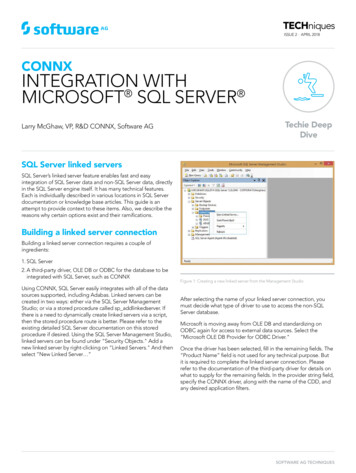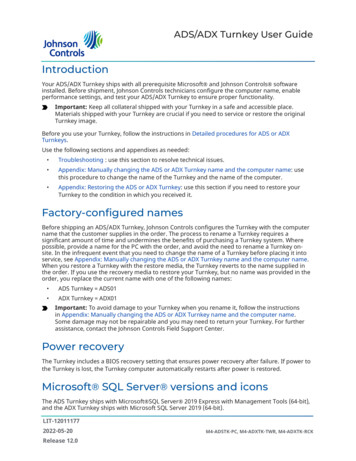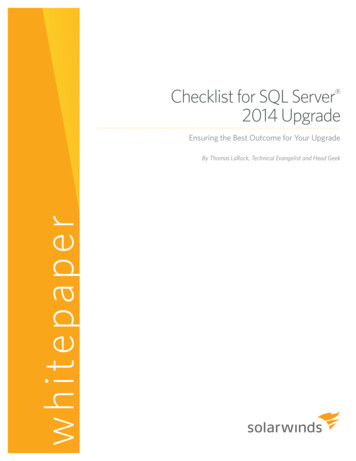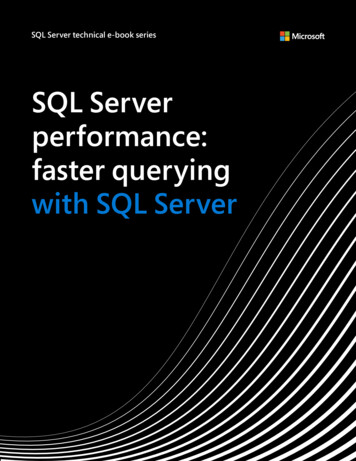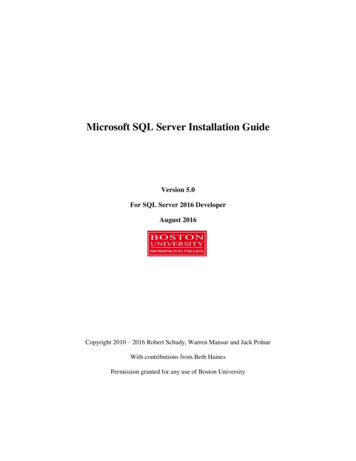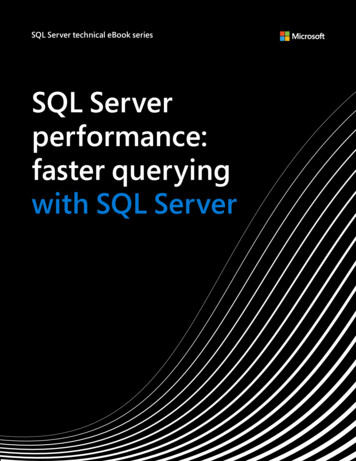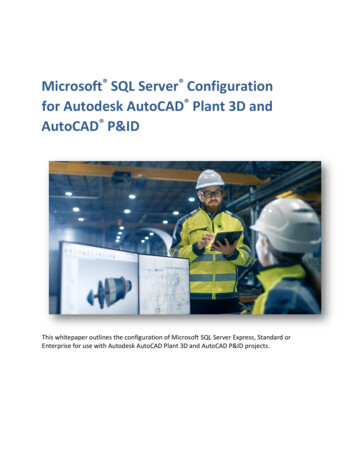
Transcription
DirectQuery in SQL Server 2016 Analysis ServicesTechnical White PaperPublished: January 2017Applies to: Microsoft SQL Server 2016 Analysis Services, TabularSummary: DirectQuery transforms the Microsoft SQL Server Analysis Services Tabular model into ametadata layer on top of an external database. For SQL Server 2016, DirectQuery was redesigned fordramatically improved speed and performance, however, it is also now more complex to understand andimplement. There are many tradeoffs to consider when deciding when to use DirectQuery versus inmemory mode (VertiPaq). Consider using DirectQuery if you have either a small database that is updatedfrequently or a large database that would not fit in memory.Authors:Marco Russo (SQL Server MVP and BI Consultant at SQLBI.COM)Alberto Ferrari (SQL Server MVP and BI Consultant at SQLBI.COM)Reviewers:Kasper de Jonge, Senior Program Manager, Microsoft
The information contained in this document represents the current view of Microsoft Corporation on theissues discussed as of the date of publication. Because Microsoft must respond to changing marketconditions, it should not be interpreted to be a commitment on the part of Microsoft, and Microsoftcannot guarantee the accuracy of any information presented after the date of publication.This white paper is for informational purposes only. MICROSOFT MAKES NO WARRANTIES, EXPRESS,IMPLIED, OR STATUTORY, AS TO THE INFORMATION IN THIS DOCUMENT.Complying with all applicable copyright laws is the responsibility of the user. Without limiting the rightsunder copyright, no part of this document may be reproduced, stored in, or introduced into a retrievalsystem, or transmitted in any form or by any means (electronic, mechanical, photocopying, recording, orotherwise), or for any purpose, without the express written permission of Microsoft Corporation.Microsoft may have patents, patent applications, trademarks, copyrights, or other intellectual propertyrights covering subject matter in this document. Except as expressly provided in any written licenseagreement from Microsoft, the furnishing of this document does not give you any license to thesepatents, trademarks, copyrights, or other intellectual property. 2017 Microsoft Corporation. All rights reserved.Microsoft, Active Directory, Microsoft Azure, Bing, Excel, SharePoint, Silverlight, SQL Server, Visual Studio,Windows, and Windows Server are trademarks of the Microsoft group of companies.All other trademarks are property of their respective owners.Page 2
ContentsIntroduction . 6Introduction to Tabular processing . 6Pros & cons . 8Example comparing a model designed for in-memory versus DirectQuery . 8Introduction to DirectQuery . 8Calculated tables and columns . 10DAX . 11MDX . 11Understanding DirectQuery . 11Introducing the DirectQuery architecture . 11Using supported data sources . 13Building models for DirectQuery . 13Understanding query limits. 14Using DAX in DirectQuery. 16Semantic differences in DAX .17Using DAX measures .18Using DAX calculated columns .20Using MDX in DirectQuery . 23Using row-level security . 23Using DirectQuery, real-time, and different client tools . 24Do you need real-time systems? . 26Creating a DirectQuery model . 27Enabling DirectQuery during development .28Creating sample data for DirectQuery . 31Steps to add a partition with sample data: .31Steps to populate sample partitions: .32Setting DirectQuery mode after deployment . 33Setting DirectQuery with SSMS.34Setting DirectQuery with XMLA .35Setting DirectQuery with PowerShell .35Security setting in DirectQuery . 36Security and impersonation with DirectQuery .36Page 3
To use impersonation: .37Using Row-level security on SQL Server earlier than 2016 .39Steps to implement row-level security on SQL Server earlier than 2016: .39Optimizing DirectQuery . 40Understanding datatype handling in DirectQuery . 40Simple query on a star schema and on snowflake schemas . 41Filter over a calculated column . 44Using time intelligence functions with additive measures . 47Using time intelligence functions with non-additive measures. 50Using time intelligence functions with semi-additive measures . 51Many-to-many relationships . 54Comparing DirectQuery with in-memory mode (VertiPaq) . 56Conclusion . 56More information . 58Appendix A: Semantic differences in DAX . 59Comparisons . 59Comparisons of strings and numbers .59Comparison of text with Boolean .59Comparison of nulls .60Casts . 60Cast from string to Boolean .60Cast from string to date/time .60Cast from string to other non-Boolean values .60Cast from numbers to string not allowed .61No support for two-try casts in DirectQuery .61Math functions and arithmetic operations . 61Order of addition .61Use of the POWER function .61Numerical overflow operations .62LOG functions with blanks return different results .62Division by 0 and division by Blank .62Supported numeric and date-time ranges .62Floating point values supported by CEILING .63Datepart functions with dates that are out of range .63Page 4
Truncation of time values .64SQL Time data type not supported .64Currency .64Combining currency and real data types .64Operation results in an out-of-range value .65Combining currency with other data types .65Aggregation functions . 65Statistical functions over a table with a single row .65Text functions . 65String length affects results .66Implicit TRIM in the middle of strings .66Implicit RTRIM with use of LEN function .66In-memory supports additional parameters for SUBSTITUTE .66Restrictions on string lengths for REPT operations .67Substring operations return different results depending on character type .67Page 5
IntroductionDirectQuery is a technology introduced in Microsoft SQL Server Analysis Services 2012 (SSAS) Tabularmodels. It transforms the Tabular model into a metadata layer on top of an external database. In fact, byusing DirectQuery, the Tabular engine no longer processes data in its own internal database. Instead, thequery is transformed into a set of SQL queries that are sent to the underlying relational database. Oncethe SQL database returns the requested data, the Tabular engine further processes that data. This allowsyou to create real-time data models, because you no longer need to update the internal data structures.Every query is executed against the relational database, and the data is processed as it becomes availablefrom the SQL query. By using cartridge interfaces, the Tabular engine can connect to various databaseengines, including Microsoft SQL Server, Oracle, Teradata, and others.In the 2012/2014 DirectQuery implementation, the Tabular engine generated a single SQL query from anyDAX query. This resulted in verbose SQL code that was too complex for most real-world scenarios. Thus,DirectQuery was not widely used in previous SSAS versions. In 2016, Microsoft overhauled theDirectQuery technology. The resulting implementation is much more advanced and, consequently, bothfaster and more complex to understand.Before using DirectQuery to turn your SSAS 2016 Tabular model into a real-time model, you first need tounderstand how DirectQuery works. It’s important to understand implementation details as well as thepros and cons of using the technology.This whitepaper gives you all the relevant information needed to understand and use DirectQuery in yourenvironment. We strongly encourage you to read it from cover to cover before beginning yourimplementation. DirectQuery comes with some limitations in the modeling and DAX options that willaffect how you build the data model itself. DirectQuery requires a different data model than standardTabular models that import data from an in-memory database.Note: although the Tabular engine is available in the SQL Server 2016 Standard edition, DirectQuery is anadvanced feature available only in the Enterprise edition.Introduction to Tabular processingBefore discussing the differences between DirectQuery and a regular Tabular model, it’s important tounderstand how Tabular processing and querying works. This paper assumes you are familiar with Tabularmodels, but gives a brief recap of Tabular processing and querying. For more information on Tabularmodels, see the resources section at the end of this paper.A SQL Server Analysis Services (SSAS) Tabular database is a semantic model that usually keeps a copy ofthe data in an in-memory columnar database, which reads data from data sources, processes them into itsinternal data structure, and finally answers queries by reading its internal data model. By usingDirectQuery, the SSAS Tabular database behaves as a semantic model that translates incoming queries tothe data source, without keeping a copy of the data in an in-memory database.Page 6
The columnar database used by SSAS is an in-memory engine (VertiPaq). The data sources are typicallyrelational databases, but due to the many different data sources available for SSAS, you can load data intoSSAS from virtually any data source, including text files, web services, or Excel workbooks. You can useand mix any of the available data sources because of the intermediate processing phase.You typically create a SSAS Tabular solution in one of two ways: Feed the SSAS solution from the data warehouse that contains all the data relevant to yourcompany, which is already prepared for analysis. In this case, you typically have a single source ofdata, and this data source is a relational database (can be Microsoft SQL Server or any supportedrelational database). Feed the SSAS solution from multiple data sources (and probably different data types), and useSSAS to integrate data from different databases. In this case, you typically have some relationaldatabases, maybe more than one, and other data sources like text files, Excel files, or other datasources.In both cases, data is read from the source database and transformed into an in-memory database—highly optimized for querying, and compressed to use less memory. Remember, SSAS engine is the inmemory columnar database that stores and hosts your BI model, and data compression is important. Datais initially saved to disk and loaded when the database is first accessed after a SSAS service restart. Afterthat, all queries are run in RAM, unless you have paging active, which is not recommended for an inmemory engine. Once the data has been processed and stored in memory, you no longer need toconnect to the source database(s).The processing phase comes with the following advantages: Data is compressed and stored in a format that makes queries much faster. Data can come from different data sources and be transformed into a single format. The in-memory engine contains several optimizations for memory access, because all the data isstored in RAM.The processing phase has the following disadvantages: Processing takes time, so real-time queries are not an option. By implementing sophisticatedtechniques, it’s possible to build near real-time models with latency times in the minutes. However,there is no way to make sure that the query executed by SSAS Tabular references the latest changesto the original data source. Processing requires a lot of CPU power. During data processing, the server is busy and typicallydoesn’t have the resources to answer queries efficiently. Since this is an in-memory database, if the database you are working on does not fit into memory,you’ll need to buy more RAM (best option), or optimize the data model’s memory usage, which isa complex task. Data needs to be moved from the source database to the SSAS storage. When dealing with largeamounts of data, just moving the data over the network can take a significant amount of time.Page 7
Pros & consWhen using DirectQuery, pros become cons and vice versa. In fact, if you build a model that is enabled touse DirectQuery, your model will not have any in-memory (VertiPaq) storage, and it will not need toprocess data. Thus, data is always real-time—there is no processing time, no memory limitations, and datadoes not need to be moved from the source database to the SSAS database. On the other hand, you losethe tremendous speed of the in-memory engine. You will not be able to integrate data coming fromdifferent data sources, and the effort of answering queries moves from SSAS to the database enginehosting the information.There is no golden rule to tell you if DirectQuery is better for your model than regular in-memory storage.You will need to carefully balance advantages and disadvantages and, once you have decided, workthrough the optimization of your model, which depends on the technology you used.Example comparing a model designed forin-memory versus DirectQueryIn-memory model (VertiPaq)During processing, the SSAS engine will execute a SELECT statement over the entire table, reading allthe rows and performing its own processing steps. This means you need to optimize your data source fora huge single scan of the table. Indexes are useless, and partitioning, if needed, should be aligned withpartitions defined in your SSAS solution.DirectQuery modelIf the same data need to be used by DirectQuery, then your table will be accessed at least once for eachquery and, out of the whole table, only a small subset of it might be needed for the query. In this case,you need to optimize the SQL model to quickly answer the queries generated by DirectQuery. Thisincludes creating the correct indexes on the table, and probably partitioning it to reduce I/O activityduring query execution.How does the model impact decisions?If you plan to use an in-memory engine, then a columnstore index on a table stored inMicrosoft SQL Server is far from ideal. If you plan to use DirectQuery, then the same columnstore index isa much-needed option. As you see, it’s important to design your database to fit your use case.The previous example showed the kind of decisions you’ll have to make when implementing DirectQueryinto your solution. In the next section, we’ll further explore the subtle differences between the DirectQueryand in-memory models.Introduction to DirectQueryNow that you’ve seen how the DirectQuery and in-memory (VertiPaq) models process data, we’ll look athow they handle queries.Page 8
Every query sent to a Tabular model is executed by two layers of calculation, called Storage Engine (SE)and Formula Engine (FE). The storage engine is responsible for retrieving data from the database, whereasthe formula engine uses the information returned by the storage engine and performs more advancedcalculations. For example, if you want to retrieve the top three products by sales amount, SE accesses thesource database and computes the list of all products along with the sales amount for each product,whereas FE sorts the resulting data set and retrieves the first three products. Thus, SE reads data from thesource database while FE reads data from SE.Going deeper, Analysis Services parses both DAX and MDX queries, and then transforms them in queryplans that are executed by the formula engine. The formula engine is able to execute any function andoperation for both languages. In order to retrieve the raw data and perform calculations, the formulaengine makes several calls to the storage engine. In SSAS 2016, the storage engine can be a choicebetween the in-memory analytics engine (VertiPaq) and the external relational database (DirectQuery).You choose which of the two storage engines to use at the data model level. This means that a datamodel can use only one of the two engines, but not both in the same model.As you see in Figure 1, the VertiPaq database contains a cached copy of the data that was read from thedata source when you last refreshed the data model. In contrast, DirectQuery forwards requests to theexternal data source when necessary, allowing for real-time queries. The VertiPaq engine accepts requestsin internal binary structures (externally described using a human-readable format called xmSQL), whereasDirectQuery cartridges accept requests using the SQL language, in the dialect supported by the cartridgeitself.Figure 1 DirectQuery architecture in SQL Server 2016 Analysis Services for tabular modelsThis is different than how things worked in SSAS 2012/2014. In fact, in previous versions of SSAS, you hadthe option of building hybrid models, where the client tool had the option of running a query in eitherstandard VertiPaq mode or in DirectQuery mode, as you see in Figure 2.Page 9
Figure 2 Former DirectQuery architecture in SQL Server Analysis Services 2012/2014 for tabular modelsIn SSAS 2016, the hybrid mode is no longer available, but this is not a big limitation. As we said earlier, theuse of DirectQuery in SSAS 2012/2014 was limited to a few specific scenarios. The rest of this whitepaperwill only cover DirectQuery in SSAS 2016.DirectQuery interacts with relational databases and, in order to use the database at its best, it usescartridges to support the specific dialect of the server that it uses. At the time of writing, the availablecartridges are: Microsoft SQL Server (version 2008 or later) Microsoft SQL Azure Database Microsoft Azure SQL Data Warehouse Microsoft Analytics Platform System (APS) Oracle (version 9i or later) Teradata (V2R6, V12)For a current list of supported databases and versions, 92165.aspx.Calculated tables and columnsAs explained earlier: An in-memory database engine (VertiPaq) can store data. DirectQuery is an interface to an existing database. It can only provide data that already exists inthe source system.The difference between VertiPaq and DirectQuery is important when considering calculated tables andcolumns: Calculated tables—DirectQuery does not support calculated tables, mainly because there is noplace to store them.Page 10
Calculated columns—You can use calculated columns with DirectQuery, although with somelimitations that we’ll describe later.DAXSome DAX functions have different semantics, because they are converted in correspondent SQLexpressions instead of being executed by the in-memory engine. Thus, you might observe inconsistentbehavior across platforms when using Time Intelligence functions and Statistical functions. There arealso DAX functions not supported in DirectQuery, and the SSDT designer reports that when you switch amodel to DirectQuery.MDXMDX has some limitations in DirectQuery that affect only the MDX coding style. You cannot use: Relative names Session-scope MDX statements Tuples with members from different levels in MDX subselect clausesOther limitations affect the data model design. For example, you cannot reference user-definedhierarchies in an MDX query sent to a model using DirectQuery. This impacts the usability of DirectQueryfrom Excel, because the feature works without any issue when you use an in-memory storage engine.Understanding DirectQueryIn this section, we provide a more complete description of the DirectQuery overall architecture, andexplain in more detail how the DirectQuery technology works.Introducing the DirectQuery architectureAs we described in the introduction, DirectQuery is an alternative to an in-memory storage engine(VertiPaq). In SSAS, there is a single formula engine and two different storage engines, as already seen inFigure 1.Remember, the storage engine is in charge of retrieving data sets from the database, whereas the formulaengine performs calculations on top of the data returned by the storage engine. The two engines need towork closely together in order to provide the best performance. In fact, a clear separation between thetwo would produce sub-optimal query plans. Here is an example.SalesAmt : SUMX ( Sales, Sales[Quantity] * Sales[Unit Price] )The measure references two columns from the database—Quantity and Unit Price. If the two engineswere completely separated, then this is how SSAS would resolve the query: The formula engine asks the storage engine for a data set with Quantity and Unit Price.Page 11
Once the data set is returned, the formula engine iterates on it, performs the calculation (a simplemultiplication, in this case), and finally provides the result.In SQL, this plan would result in a single SQL query like the one shown here:SELECTSalesQuantity,UnitPriceFROMSalesAs you might imagine, for a Sales table with hundreds of millions of rows, this operation would requirethe storage engine to return a large amount of data. The time needed to allocate RAM and transfer datafrom the database would be significant. In reality, saying that the storage engine can only retrieve datafrom the database, leaving all computation to the formula engine, is too strong a statement. In fact, thestorage engine is able to perform some computation by itself, even if it does not support all DAXfunctions. Because the storage engine can easily handle simple multiplication, the query above will beresolved as follows: The formula engine asks the storage engine for a data set containing the sum of the multiplicationof Quantity by Net Price. The storage engine scans the database, then computes the result and returns a single row. The formula engine takes the result and packages it into the final result set.In SQL, a query executed by the database engine would be very different than the previous one:SELECTSUM ( SalesQuantity * UnitPrice ) AS ResultFROMSalesThis latter query scans the tables
does not need to be moved from the source database to the SSAS database. On the other hand, you lose the tremendous speed of the in-memory engine. You will not be able to integrate data coming from different data sources, and the effort of answering queries moves from SSAS to the database engine hosting the information.


